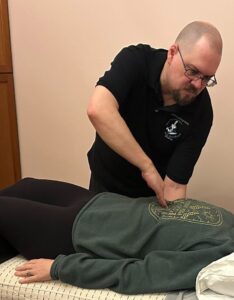
Shiatsu Treatment Shiatsu is a Japanese therapeutic modality. It aims to balance the “Ki” (or “Qi” pronounced Chi), considered the vital life force energy, through the body by applying pressure on specific points along energy pathways called meridians. As a Shiatsu practitioner, I work to unblock any stagnation in the Ki flow and create space in the body to promote overall well-being. Shiatsu is based on over 4,000 years of Traditional Chinese Medicine (TCM), where imbalances in Ki are believed to lead to illness and pain.
Here’s what a typical Shiatsu treatment might look like:
- Consultation The therapist begins with a consultation to understand the client’s needs, complaints, and health history.
- Preparation: The client remains fully clothed and lies on a massage table. (so be sure to wear something comfortable and easy to move in. ) The therapist will perform a quick Hara assessment to help form a treatment based on your session goals.
- Techniques: The therapist uses their thumbs, palms, elbows, knees, and sometimes even feet to apply pressure to specific points on the body. They may also use stretching, holding, and leaning techniques to facilitate the flow of energy.
- Focus Areas: Treatment can target general well-being or specific issues like muscle pain, poor sleep, stress, anxiety, or chronic conditions. The therapist tailors the treatment to the client’s unique needs.
- Relaxation: Throughout the session, the goal is deep relaxation and balancing the body’s energy. It aims to activate the body’s self-healing processes and restore natural balance.
While Shiatsu uses pressure points, it should never be “painful”. The pressure can be adjusted but typically falls somewhere between a gentle relaxation massage and a therapeutic deep-tissue treatment.
The experience is deeply relaxing and can leave clients feeling rejuvenated and centered. It does this by activating the parasympathetic nervous system to help put the body into “Rest and Digest” mode, facilitating self-repair. It’s not just about addressing physical complaints but also fostering a sense of mental and emotional well-being and balance.
